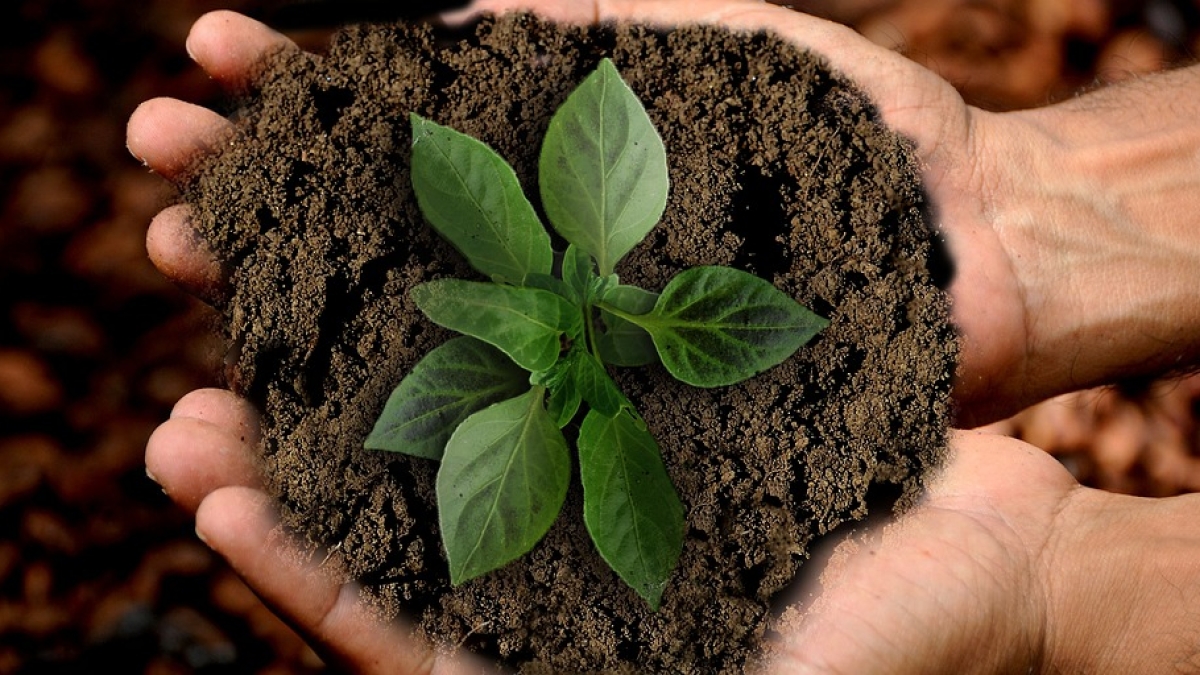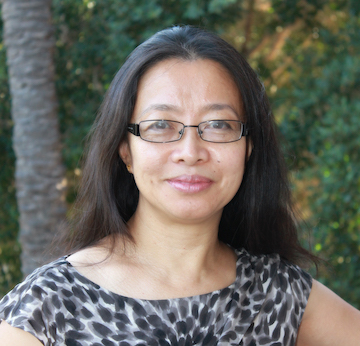Sustainability, a concept often thought of in simpler terms of the environment, is really a broader discipline that includes social justice and economic well-being. According to one of Arizona State University's leading sustainability professors, the discipline functions best when science can be connected to people.
“Sustainability encompasses the best practices for life, and that means looking at the social aspects as well as the science,” said Nalini Chhetri, an associate director for international initiatives and clinical associate professor in the School for the Future of Innovation and Society and School of Sustainability within the College of Global Futures. “We cannot look at the subject strictly in terms of climate or economics. Given its transdisciplinary nature and its value-laden attributes, we need to look at sustainability with a different lens and focus especially on how it addresses inequity.”
Chhetri’s work centers on climate impacts and communication, technological impacts in developing nations, knowledge systems, gender and urban sustainability.
ASU Now spoke to Chhetri in advance of Earth Day, which falls on April 22. The 51st annual event will include rallies, conferences, outdoor activities and service projects around the world as well as at ASU.
Nalini Chherti
Question: What do you think of Earth Day in terms of its impact on society and its messaging to the public?
Answer: Earth Day is really important because it captures the imagination and allows everybody, albeit briefly, to concentrate on what it is we want to do in terms of sustainability. As humans in the modern age, we tend to have a very small attention span, partly because we are so inundated with information. So, to have a day focused on an event such as Earth Day combined with events, discussions and forums throughout the month of April allows us to really reflect and think about it. For those who just want to skim the surface of what Earth Day means, that is OK. For those who want to take it a step further, there’s also opportunity to find out more about Earth Day and how they want to contribute on a deeper level.
For me, though, the most important part of this is finding a way to reach out to the younger generation, such as students, the ones who might not have had exposure like the older generations. If it’s fun or has value, it sticks in their mind and allows them to move forward and ask, “What kind of world do I want to see in the future?”
Q: Your undergraduate degree is in zoology. How did you transition from that to sustainability and what captured your imagination to the point where you have made this your life’s work?
A: I have always been a nerdy kid and science was something I’ve always been fascinated with. At one point I also wanted to become a medical doctor because I thought I would like to save the world. But I also thought I could do that with science. After I graduated, I got an opportunity to work for a nonprofit organization called Care International. I had had mostly academic knowledge up to that point and though my family came from very modest means, I still did not know what the world was about. This opportunity gave me great exposure to the stark realities of life, what it means to live in extreme poverty, and what it means to live sustainably.
I have held people dying of starvation in my arms. I have taken out maggots from an Indigenous woman’s head. I have worked with governments to help them develop forest and watershed management plans. I have worked in women empowerment and literacy, in agriculture and sustainable livelihood development. I worked in remote areas of the world including in Asia, Africa and Latin America, and in the past two decades and a half, have begun to understand what sustainable development is about, I think. It is more than protecting the environment – it is about the people who live in these environments. I have also realized more than anything that sustainability is about so many things. It’s about people. It’s about policy. It’s about practice. It’s about institutional changes. Systemic change. And science.
Having those life experiences combined with my academic training has allowed me to gain a more comprehensive understanding of the transdisciplinary aspect of sustainability. I bring that to my class, to my research and to my students. It’s also equipped me to take a more realistic look at sustainability and hopefully pass that knowledge on to the next generation, whenever I can.
Q: Your curriculum covers a lot of territory — poverty, world hunger, wealth, gender, equality and urban development. Many might think, what do those issues have to do with sustainability?
A: The world of sustainability encompasses best practices for life, and that means all of those subjects you just mentioned. If you’re trying to build a smart city or town, you’ll encounter these issues. It’s about a system and all the parts are linked and interconnected. They are not siloed. That’s why it’s important for my students not to just study this academically, but to figure out how to transition that learning to policy and practice. That is why leveraging many of ASU's design principles makes sense in sustainability, such as to be socially embedded in our communities.
Sustainability is not just about environmental economics because it’s also social sustainability and does use-inspired research. It should focus on inherent and systemic inequity. Justice. Gender. Because they’re all connected. We have evidence of climate impacts that are disproportionately impacting Indigenous and vulnerable people in the U.S. and around the world. But we have the tools and knowledge to overcome those, if we want to. To do this requires expansion and honoring of all kinds of knowledge – academic, experiential, local and traditional. Knowledge should not only come from scientists and academics like us but from other knowledge systems too. Understanding and applying sustainability should be more than the domain of universities. We need to respect and apply the knowledge of all of us who are alive today as well as those who came before us.
Educational institutions cannot be these ivory towers that claim they are the keepers of knowledge. That is pure hubris. We must pass on our knowledge and research to everyone, not just for publication. That would be pretty limiting. Beyond that, we must capture the attention of politicians, technocrats and policymakers to collaborate with them to understand what their decisions will mean and how we can work to make a positive difference. That is very hard in a democracy, and even harder in such a politicized world we currently inhabit. But we have to somehow articulate our ideas and do it effectively. If the most learned and knowledgeable amongst us who populate universities cannot do it with our community of students and scholars and our combined intellect prowess, then what is our ultimate value to society?
Q: You also work with think tanks and agencies in China, Ghana, India, Jordan, Nepal and Thailand. What are their views of sustainability?
A: Well, progress depends on who the decision-makers are and how collectively the communities view sustainability. Some communities care more; some communities care less. It differs across communities and countries like everything else. And unfortunately, across the board the subject has been politicized. But we are all trying to reach the same goal, just using different pathways.
The one thing that I have learned by working with all of these institutions around the world is that they do look to the United States for ideas and collaboration. And in some aspects, and especially amongst universities, we are still looked up to in terms of how we can lead with ideas and education.
Q: So the United States should adopt the role as world leader when it comes to sustainability?
A: I don’t think there should be one leader and that would be arrogant. The United States has a population of approximately 350 million people and that’s only a small fraction of the almost 8 billion people worldwide. Having said that, we do have the highest concentration of academics, resources and federal funding. We do have an advantage in terms of intellectual skills because we still have our highly regarded university education platforms where we have debates and discourses, freely and spiritedly, leveraging different outlets. And to me, that is the heart and soul of how we advance knowledge.
I don’t think we need to be the leaders all the time and that is OK. In fact, we are not. A lot of European, Latin American, African and Asian countries are far ahead of us in terms of thinking and implementing sustainable policies, creating sustainable cities and way of life. This is a global issue – we all need to be leaders as well as followers. There is a line in one of my favorite poems which has lines that speak to this notion: “We can’t all be captains, we’ve got to be crew. There’s something for all of us here.”
So, we can do seemingly small things such as Earth Day, and big things such as large research and everything in between. Those of us who are part of the community in universities – where knowledge is paramount, we leverage that aspect strongly in sustainability.
Ways to get involved at ASU
- Earth Month events: Browse the offerings, from adopt-a-plant events to sustainability walking tours to lectures by topic experts.
- Learn the history of Earth Day: Click through a timeline of the major sustainability milestones for each year that Earth Day has been observed, on ASU's Earth Month website.
- Seeds of Sustainability: Learn about sustainability in this interactive, self-paced training in 60 minutes or less. Receive a certificate upon completion. Available to students and employees.
- Reduce and reuse: Learn about recycling, composting and Ditch the Dumpster on campus through Zero Waste.
- Staff Green Devil certification training: Search “Green Devil” in Career EDGE and discover opportunities for action and engagement. Learn about ASU’s eight sustainability initiatives and the departments leading the charge. Email Susan Norton, Sustainability Practices program manager, to join or ask questions.
- Sustainability certifications: Is your office Green Certified? Enroll in the Sustainability Certification program and learn how you can make your office space more sustainable.
- Spread awareness: Download a Zoom background to spark conversations about sustainability.
- Band together: Search Sun Devil Sync for sustainability- and environmental-related student groups and events.
Photo illustration courtesy of Pixabay.com.
More Environment and sustainability

A water fix that takes on the yuck factor
Written by Christy Spackman, an ASU assistant professor and senior global futures scientist. This essay is adapted with permission from an article in Issues in Science and Technology from her book, “…

At home in the wild
By Kristin ToussaintEditor's note: This story is featured in the winter 2025 issue of ASU Thrive.Way up in the Andes mountains in Colombia, wax palms stretch their towering, skinny trunks into the…

Switching to 'green' plastic alone won’t solve the plastic problem, study shows
Plastic is everywhere. Today alone, you have probably already touched a whole lot of it, whether it’s your phone case, sunglasses, a grocery bag or your water bottle. It’s no news that plastic…

